If you’ve been looking for a homemade yogurt recipe that’s not too tangy, but also thick and creamy you’ve come to the right spot. I’m sharing my recipe, plus all my tips for getting delicious thick yogurt every single time.
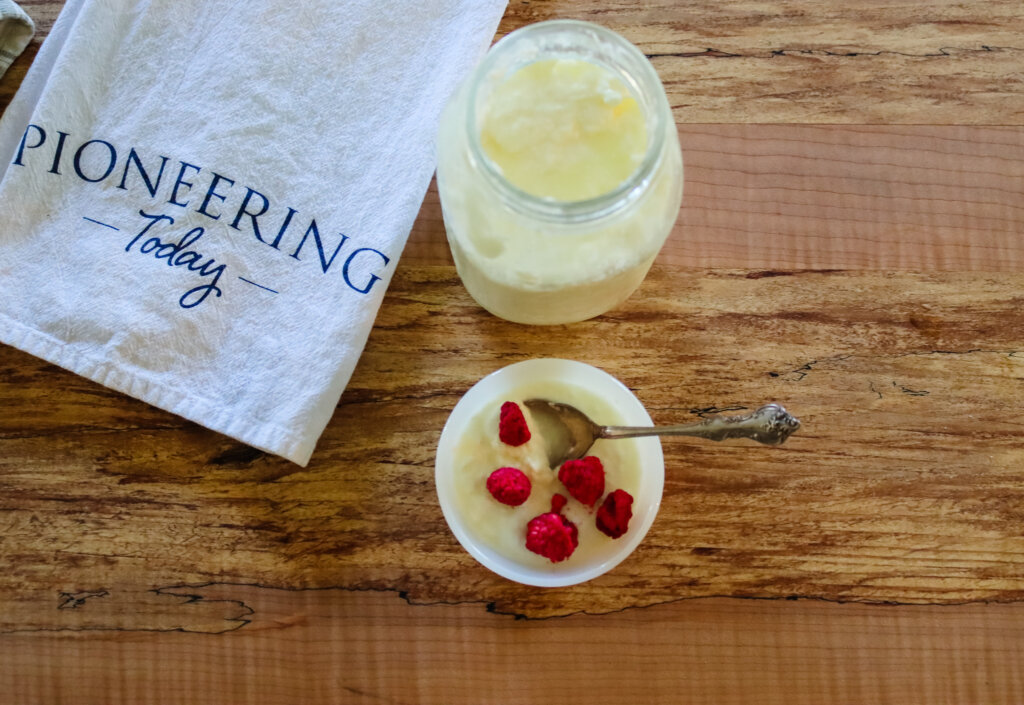
Does anyone else get a little bit excited twirl around the kitchen and do a double fist pump when they learn how to make something from scratch at home instead of purchasing it from the store?
Whew, glad it’s not just me. I spun around and may have knocked over a dish or two when I learned how to make yogurt at home without a yogurt maker or any new appliance. Because really, I hate appliances that only serve one purpose. I’m a multi-tasking girl and expect just about everything in my house to be the same way.
Some of you have been making homemade yogurt for years, and you rock. For others, it’s been on your to-do list for a good while.
If neither applies to you, check out Fermented Dairy: Why You Should Be Doing this Now. Then come back here and celebrate, because today is your day.
Today you’re going to learn how to make yogurt at home and you’ll be spinning right around with me. Okay, maybe I’m the only one who spins, but you get the point. This is exciting stuff.
Table of Contents[Hide][Show]
- Why I Love This Recipe
- Does Homemade Yogurt Save You Money?
- Health Benefits of Yogurt
- Best Ways to Enjoy Yogurt
- Ingredients & Supplies Needed
- Homemade Yogurt Recipe
- Culturing Methods
- Tips for Thick and Creamy (No-Strain) Yogurt
- More Fermentation Articles and Recipes:
- Homemade Yogurt (Thick & Creamy)
Why I Love This Recipe
Making homemade yogurt was way easier than I anticipated. I’ve made yogurt from scratch before, but it always turned out tangier and runnier than I like. If making homemade products doesn’t give me a product I enjoy, then I just won’t stick with it, which is why I love this method for making yogurt.
It turns out perfectly thick and creamy every single time. And the flavor is almost sweet, not too tangy at all!
Does Homemade Yogurt Save You Money?
One of the first things I like to look at when making something from scratch is not only if it’s more healthy, but it also has to be fairly easy AND it must be cheaper than the store-bought equivalent.
I’m happy to say, this homemade yogurt recipe fits the bill.
By making yogurt at home I’m able to cut my cost in half. In half! All it takes is about ten minutes of hands-on time.
Where I live an organic quart of plain yogurt is just shy of $5. I can purchase a half-gallon of organic grass-fed non-homogenized and non-ultra-pasteurized milk for $4.67. Using my own starter, I can make a quart of homemade yogurt for only $2.33, plus it has more live cultures in it.
I believe the fewer ingredients a recipe has the better and this homemade yogurt recipe only uses two ingredients, plus requires no straining! High-five me!

available now
Give the Gift of Homemade—All Year Long
Want to make stunning, heartfelt gifts in less time—with less stress? Get my Mason Jar Gift Guide absolutely free! Inside, you’ll discover step-by-step recipes, printable labels, and creative DIY inspiration—so you can whip up beautiful, delicious, homegrown gifts for every occasion. Perfect for anyone craving a simpler, more meaningful holiday season (or just more joy in your kitchen).
Subscribe to Melissa K. Norris!
Get updates on the latest posts and more from Melissa K. Norris straight to your inbox.
We use your personal data for interest-based advertising, as outlined in our Privacy Notice.
Health Benefits of Yogurt
We all know the health benefits of fermented foods, and yogurt fits into the category of fermented dairy. It contains a plethora of live beneficial bacteria (aka probiotics).
If you consume yogurt on a daily basis, you can pretty much toss those expensive probiotic capsules you’re taking on a daily basis out! Getting probiotics from your food is so much better for you, and less expensive.
I like to get a variety of fermented foods in my diet because each food will have different strains of beneficial bacteria. I try to eat some form of fermented vegetables, fermented dairy, and of course fermented pickles on a near-daily basis.
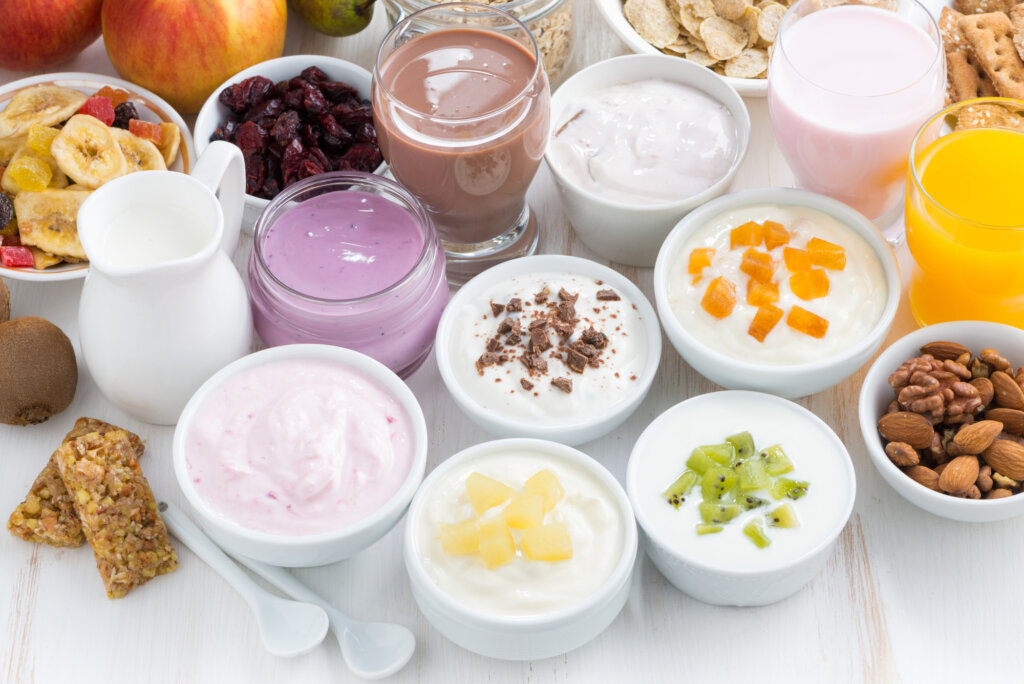
Best Ways to Enjoy Yogurt
When your yogurt is sweet, thick and ultra-creamy, you can eat it straight outta the jar! But you can also get pretty fancy with different mix-ins, or even blend it up in the blender for a scrumptious smoothy.
One of my all-time favorites, during the summer months, is to blend up a smoothie with a yogurt base, then freeze it for frozen yogurt.
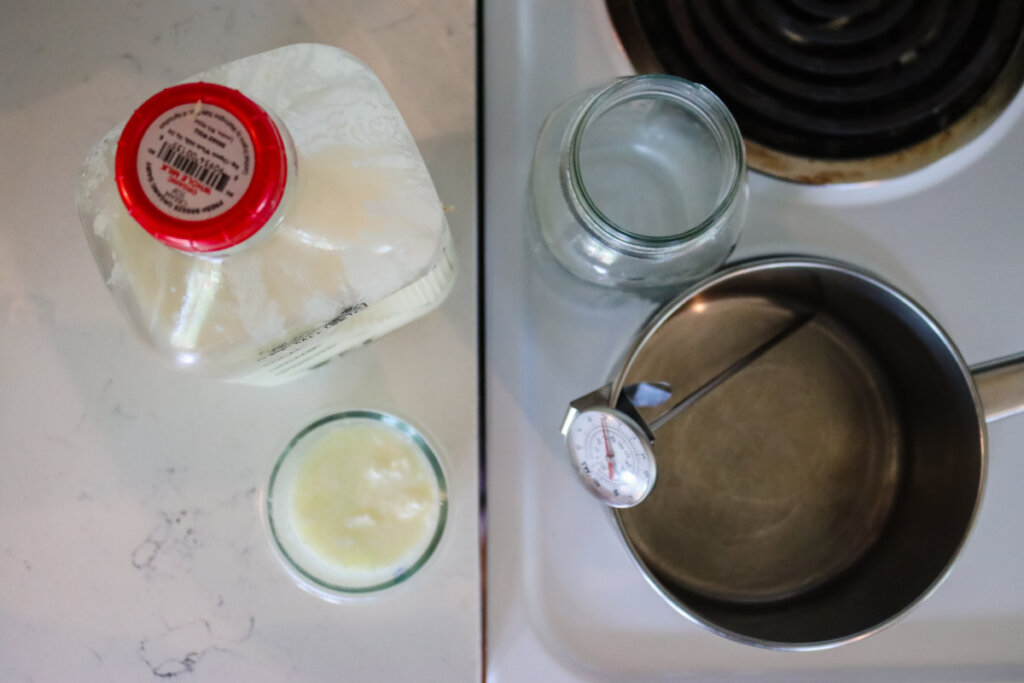
Ingredients & Supplies Needed
- Organic milk– don’t use ultra-pasteurized (see section below on the best kind of milk to use for homemade yogurt).
- Yogurt culture – this can be a previous batch of yogurt, yogurt from the store, or a purchased culture (my favorite is this heirloom bulgarain yogurt culture).
- Thermometer – you have to keep an eye on the temperature of your yogurt, a candy thermometer works perfectly! Or, you can even buy a yogurt thermometer that highlights the ideal culturing temperature.
- Quart sized Mason jar – or another container with lid to culture and store your yogurt in.
- Sauce pan – large enough to hold your milk.
Best Milk for Homemade Yogurt
If you have access to raw milk, by all means, go ahead and use it. You can find instructions for making raw milk yogurt here. However, a lot of folks don’t have access to raw milk, including myself, so the recipe below is for regular milk.
A couple of things about your milk. If money is really scarce and I have to tighten up my grocery budget, one of the things I insist upon buying organic is milk. Due to hormones and other GMO products associated with commercial dairy products, I only purchase organic butter and dairy for our home.
Homogenized Milk
I use non-homogenized and non-ultra-pasteurized milk for my yogurt. These are two different things. Homogenized milk goes through a process that breaks up the fat so it’s distributed evenly throughout the milk. This means no cream on top and no need to shake your milk. I prefer to skim off the cream for other uses or shake it up. I also believe the less processed the better, so I prefer non-homogenized.
Pasteurized vs. Ultra-Pasteurized Milk
Now let’s talk a little bit about the difference between pasteurization and ultra-pasteurization of milk.
- Pasteurization is the process of heating milk up to 161 degrees F for 15 seconds. This kills some of the bacteria and gives the milk a longer shelf life.
- Ultra-pasteurization is heating the milk up to 284 degrees F for 4 seconds, essentially killing off everything and making milk shelf stable without refrigeration for up to 9 months.
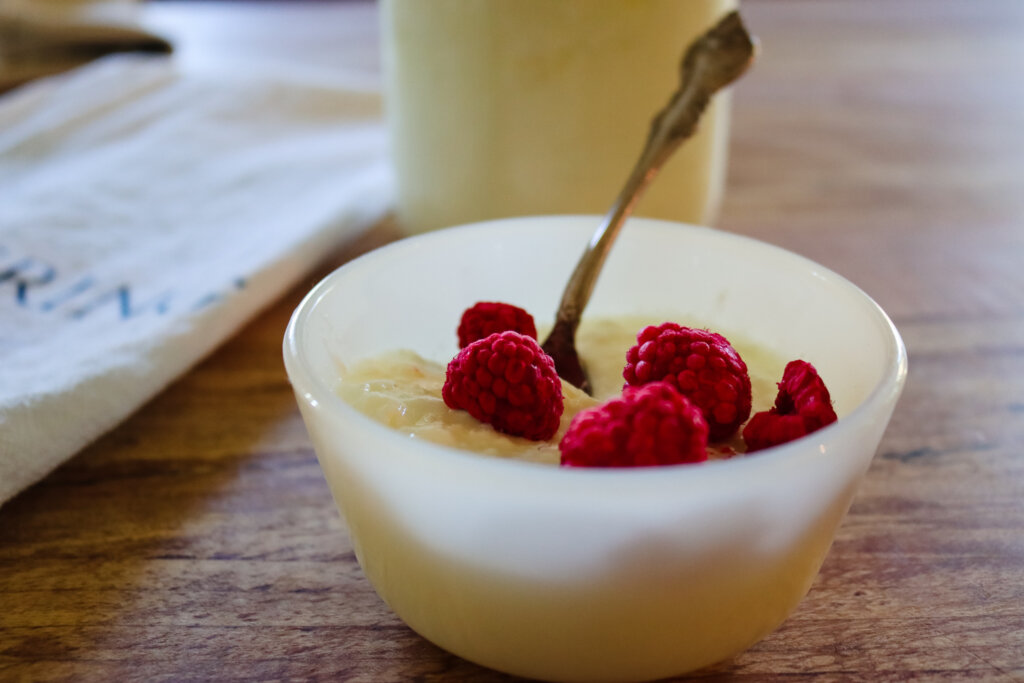
Look at Your Milk Carefully
Most milk, even organic milk, is both homogenized and ultra-pasteurized. I had to look pretty hard to find a brand that was neither. Both Fred Meyer’s and our local co-op carry Organic Valley and they have a non-homogenized non-ultra-pasteurized line in a half gallon. Beware, they also have ultra-pasteurized so carefully read the fine print on the front of the carton.
My understanding is the ultra-pasteurized milk has been heated so high, there isn’t enough food left for the live cultures to live on and make a good quality yogurt. I haven’t tested this out as I prefer the regular pasteurized milk.
Food spoils, it’s normal, and the idea of milk being able to be drinkable after months on the shelf just makes my stomach churn, ya know?
Different Yogurt Cultures
This is where we get to have some fun. Fermented food is a living thing. Live cultures are good for our intestinal system. The type of culture you use to make your homemade yogurt will determine the flavor of your yogurt.
Most people are pretty familiar with greek yogurt. It’s thick and has a very strong tangy flavor. My kids don’t like it, and I only like it when I’ve added honey and fruit…
But there are many different varieties of yogurt starters, from heirloom to direct set as well as dairy-free starters.
Heirloom Cultures are Best
It’s important to choose an heirloom culture because other cultures will lose their potency and ability to culture your milk over time. An heirloom culture, if cared for and properly maintained, will last forever.
I chose an heirloom Bulgarian starter culture because it’s sweeter and creamier than Greek yogurt. It seriously makes the best yogurt we’ve ever had. I purchased my Bulgarian culture from Cultures for Health. (Go to the “Shop by Product” dropdown menu and click “Yogurt” to see the different culture varieties.)
The cool thing is you only need to purchase a starter once, then you keep using it every time you make yogurt. It’s truly the gift that keeps on giving.
I’ve also gifted some of my starter cultures and, if you know of someone who has one, I bet you could ask them for a starter of your own! Us fermenters love to share!
Store-Bought Yogurt Culture
If you can find plain, organic yogurt from the store that says “live cultures” on it, then you can use this as your starter culture.
Homemade Yogurt Recipe
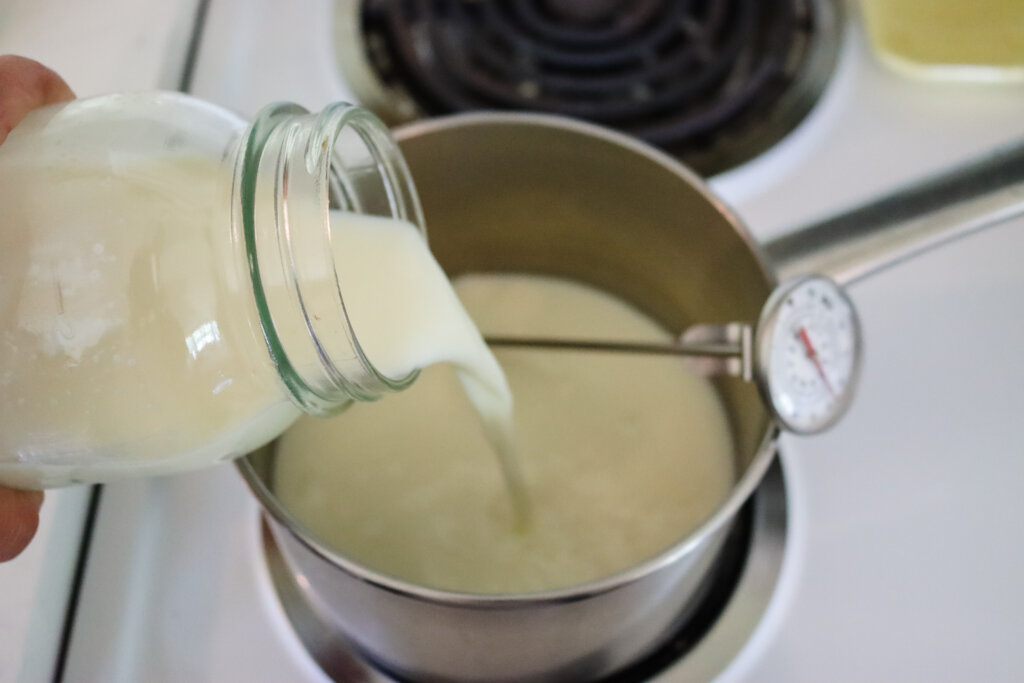
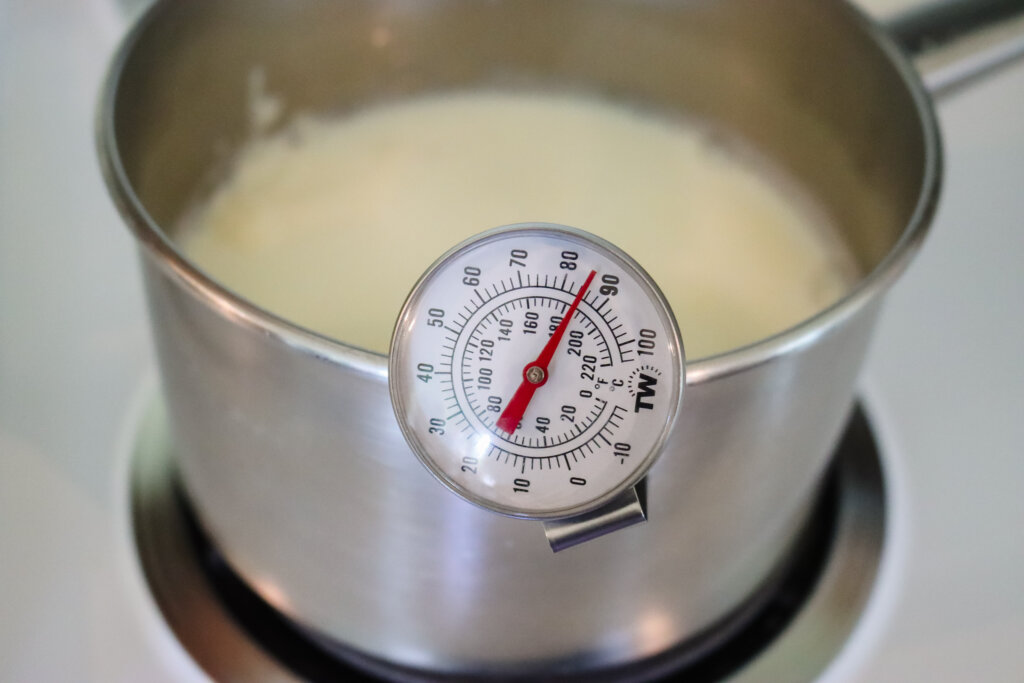
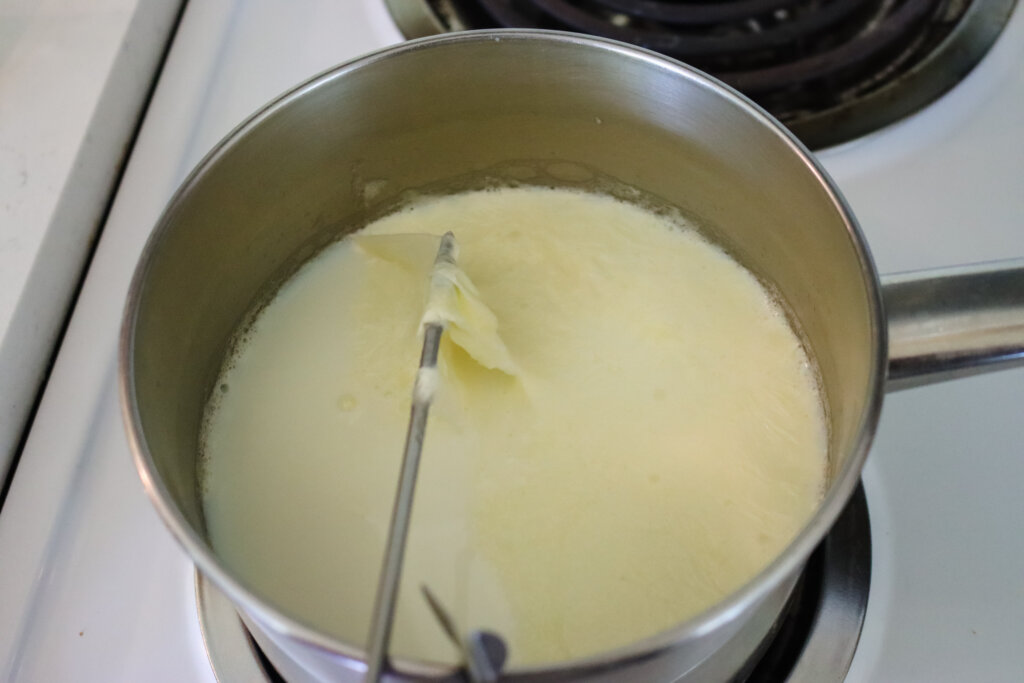
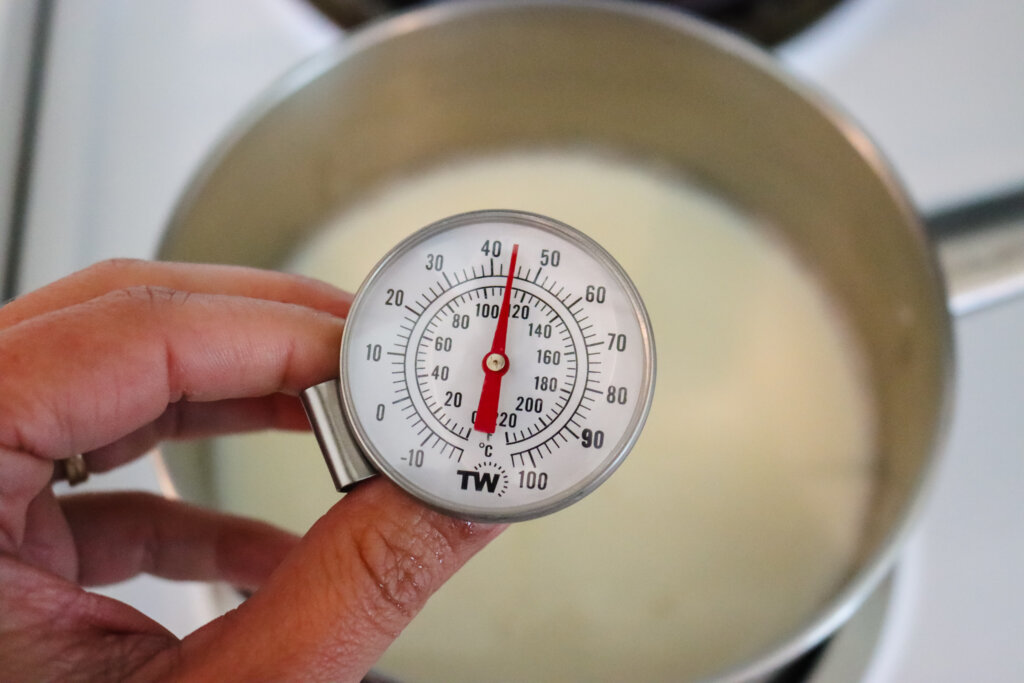
1. Pour 4-6 cups of milk into a saucepan. Over medium-low heat, slowly bring the milk up to 175 to 185 degrees F.
2. Keep the temperature up for 15-30 minutes, this step is crucial for getting that nice thick yogurt that doesn’t need straining. (See section below for more tips on how to get thick and creamy yogurt every time.)
3. After the 15-30 minutes have passed, cool the milk down to 110 degrees F. If you add the culture before the milk is cooled, you’ll kill it. If you add the culture into cold milk, it won’t culture. It just likes to be warm, not hot, not cold.
4. Skim off the layer of scalded milk with a spoon.
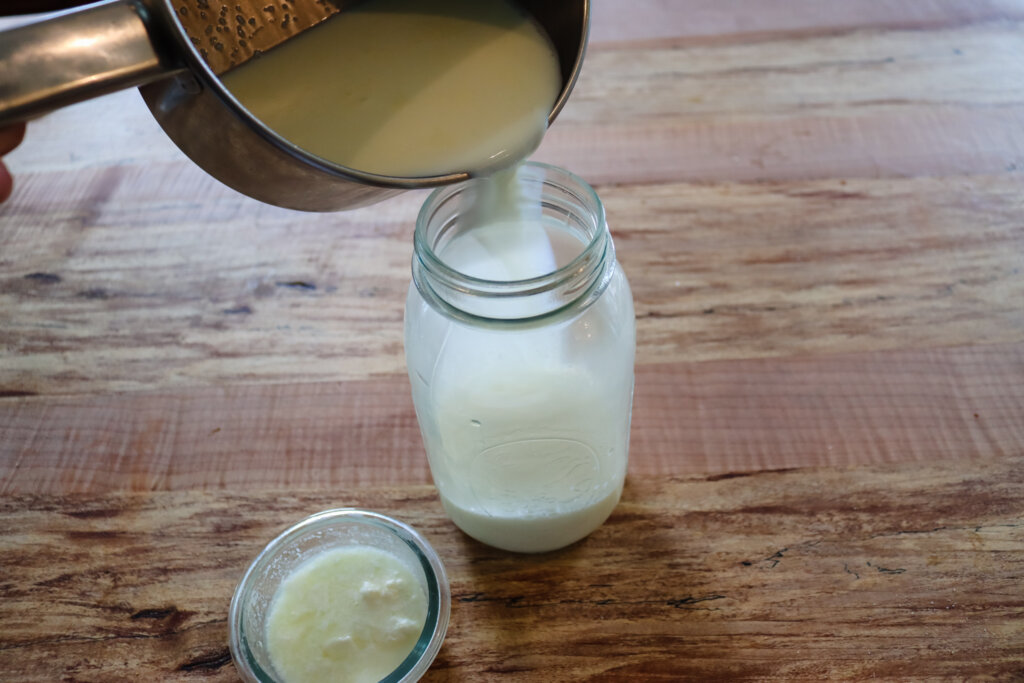

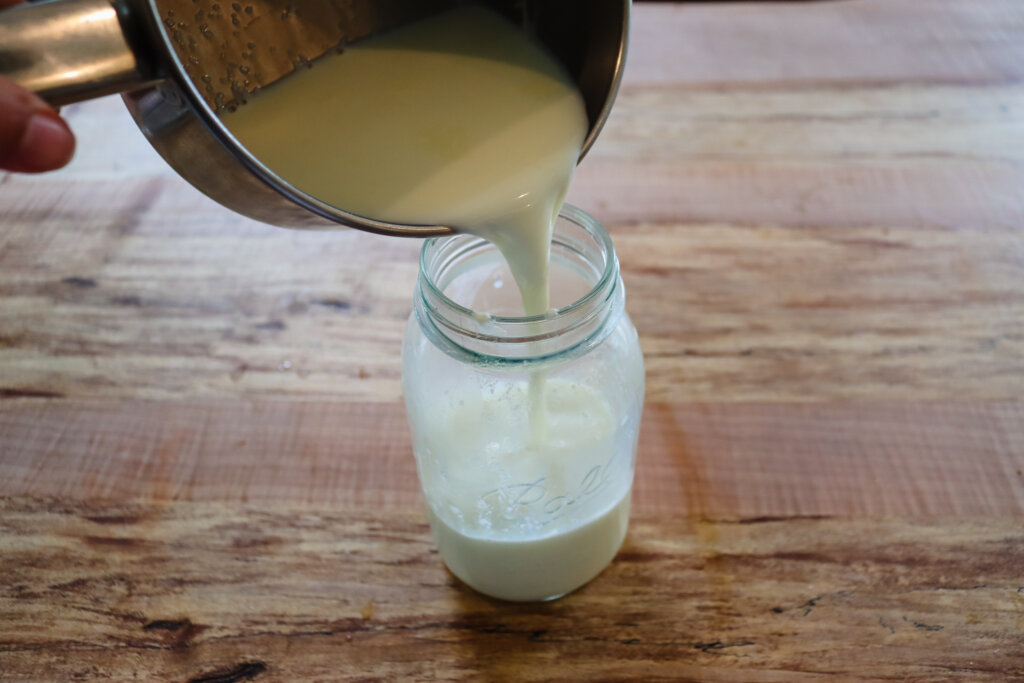
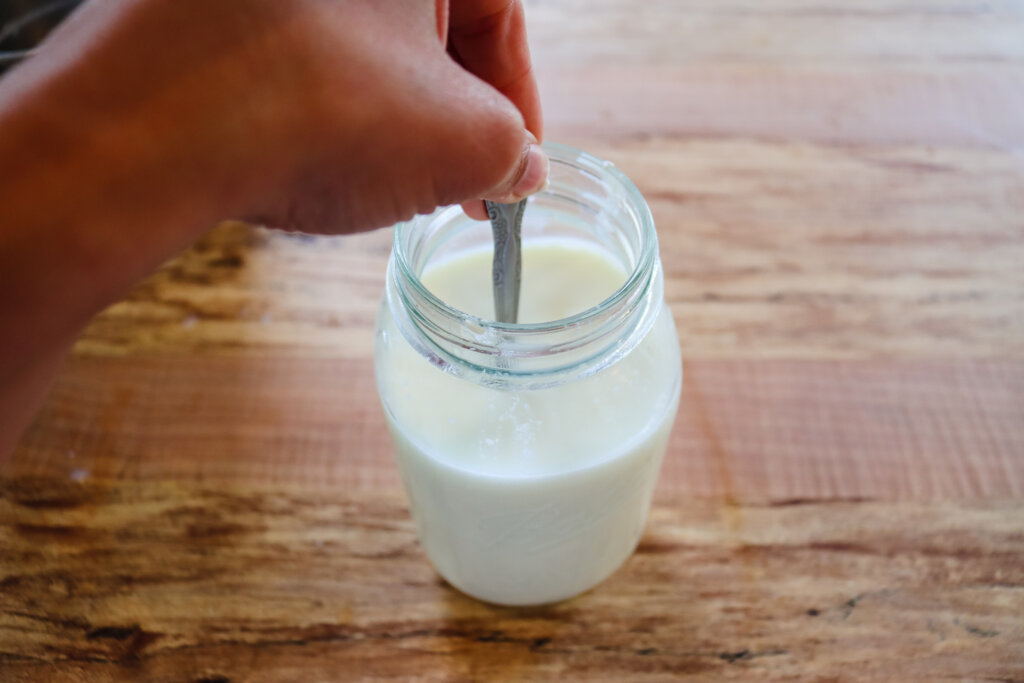
5. Pour the warm milk into a clean glass Mason jar. Add starter culture (1/4 cup yogurt or starter culture powder) and mix in thoroughly.
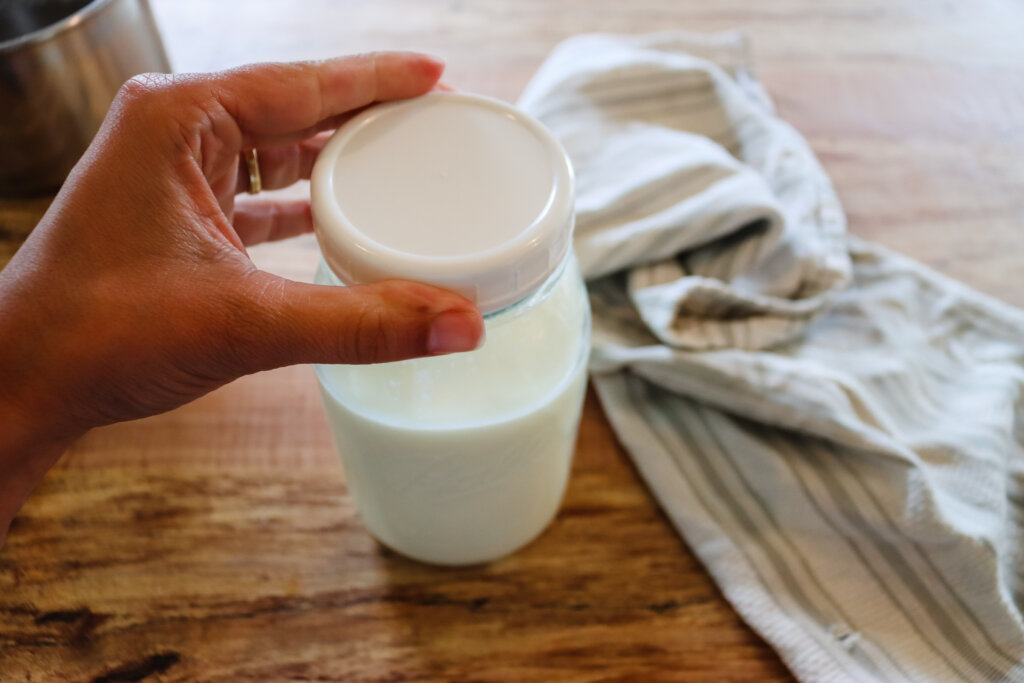
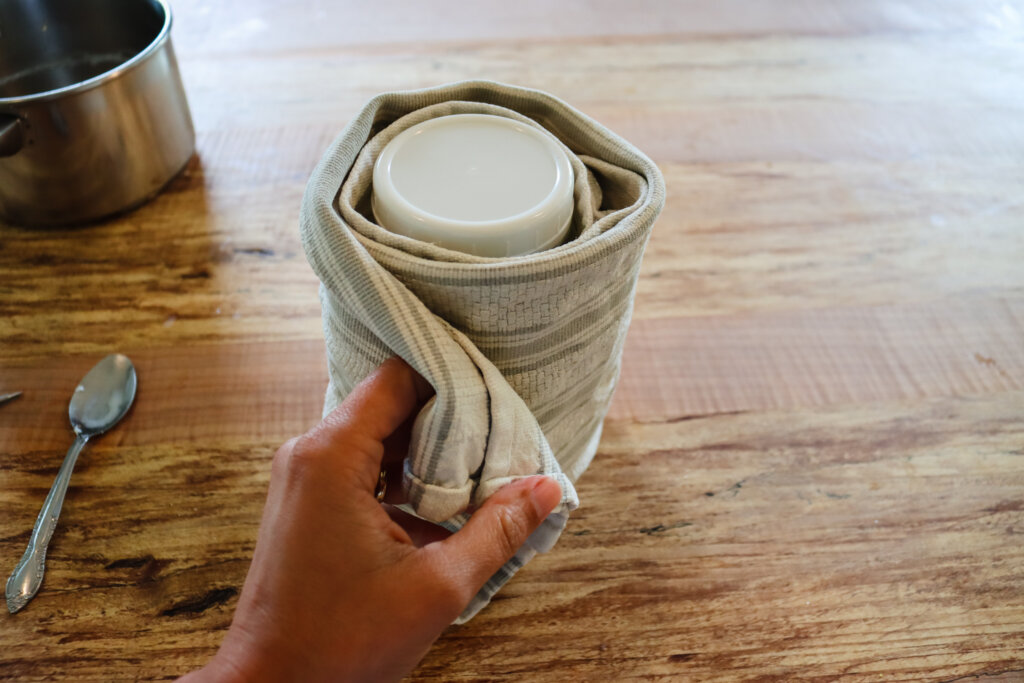
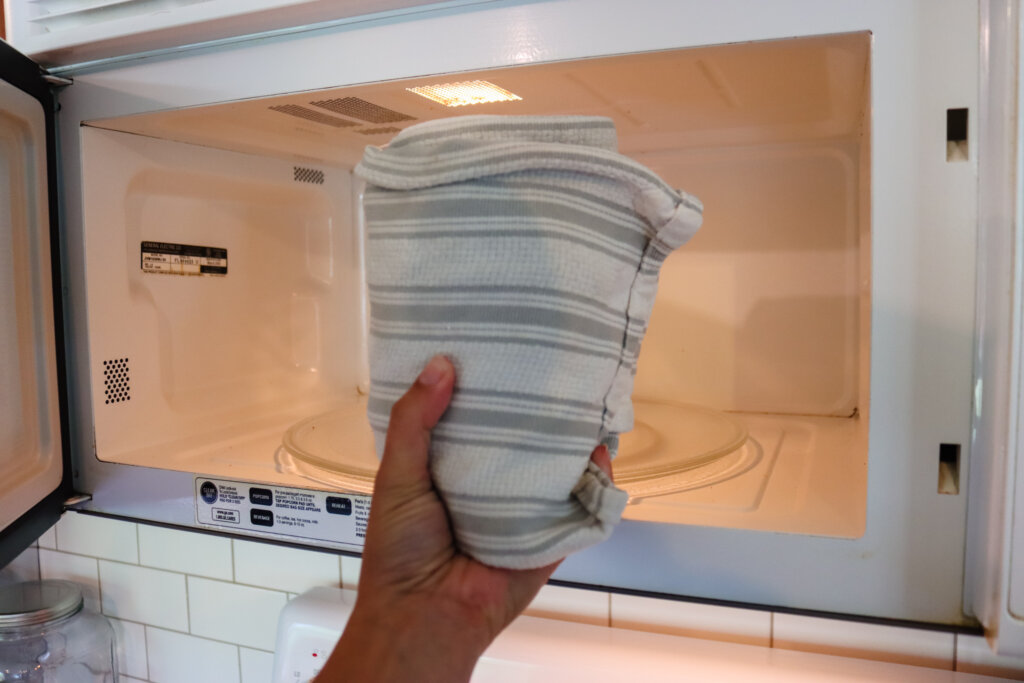
6. Put a lid on your jar. I use these plastic re-usable lids. I tend to use my Mason jars for everything from leftovers to cups on the go, so the plastic lids are great as keeping track of bands drives me crazy.
7. Keep yogurt at 110 degrees F for 4 to 8 hours. See culturing methods below to choose the one that works best for you.
8. There are a few ways to do this. You can purchase a yogurt maker, but I prefer the more frugal route when possible. Some folks wrap their jars in towels and place it in an ice chest. I prefer to use my slow cooker, fill it halfway with water, and set it on the keep warm setting, which happens to be 110 degrees.
9. After 4 to 6 hours, check to see if your yogurt is thick. If not, continue culturing for another two hours, then transfer to the refrigerator and store for up to two weeks, if you don’t gobble it up within a day or two.
Culturing Methods
There are a few ways to culture your yogurt. Pick the option that works best for you, or what you have available:
- Yogurt Maker – As I mentioned before, I don’t own kitchen appliances that don’t pull double-duty, so I don’t have a yogurt maker.
- Instant Pot – If your Instant Pot has a yogurt setting, as mine does, you can use your Instant Pot to culture the yogurt! It will keep your milk at a perfect 110 degrees F. However, I don’t like to tie my Instant Pot up for 4-6 hours at a time, so this option doesn’t work well for me.
- Towels & Ice Chest – I’ve heard many people use the towel and ice chest method. Simply wrap your jars in large towels, then place them into an ice chest and close the lid. Some peope even add jars filled with boiling water to the ice chest to maintain more heat.
- Crockpot – In the past, I used to fill my crockpot about halfway with hot water, place my jars of yogurt into the crockpot then turn the knob to “keep warm”. This would work great for me, but you’ll want to test your crockpot settings to make sure it’s not heating your milk up too much.
- Microwave or Oven Light – What I do now is I place my jars, wrapped in towels, into my microwave. If I turn on the overhead light to my stovetop, this heats up the microwave to the perfect “incubating” temperature to culture my yogurt. Some people will wrap their jars in towels and place them in the oven with the light on.
Choose the option that works best for you, or try them all until you find your favorite! I’ve done many of them over the years and the microwave is just what works best at this time.
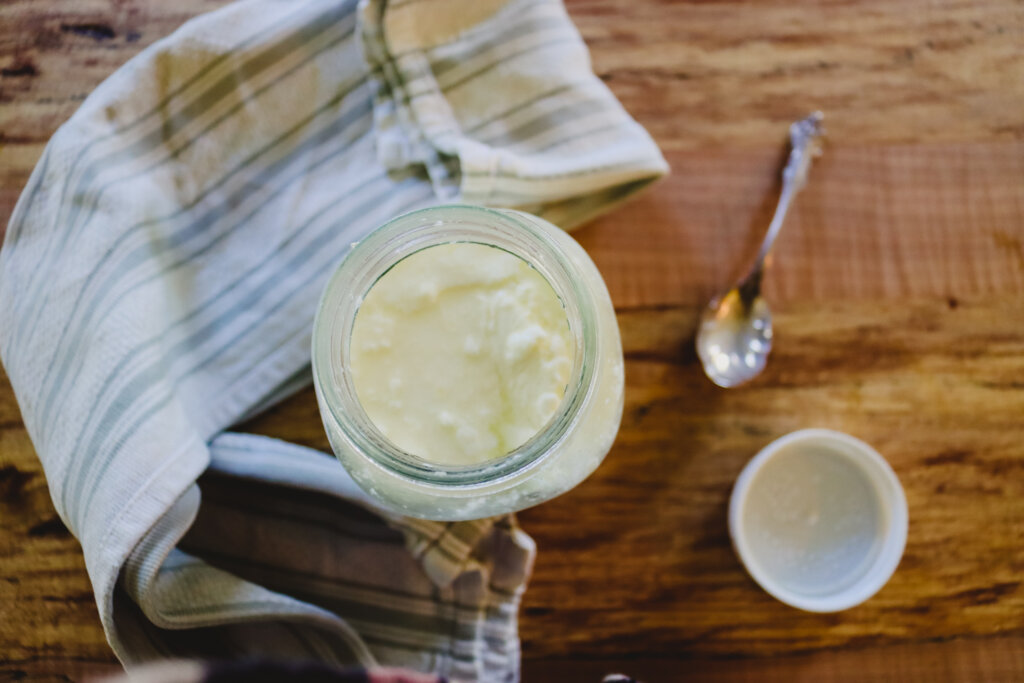
Tips for Thick and Creamy (No-Strain) Yogurt
I don’t have time for straining yogurt. There are times when I need whey and want a homemade yogurt cheese, and that’s when I use this 3 easy steps to whey tutorial.
But the rest of the time, I want a yogurt that’s thick, creamy, and requires no extra work on my part. Are ya with me? Yes? See, that’s why we’re friends.
- When your milk is heated to approximately 181 degrees F keep it at this temperature for 15 to 30 minutes. The longer heating time helps create a thicker yogurt, which means no straining!
The heating of the milk isn’t about pasteurization or killing bacteria, it actually breaks down a protein in the milk allowing it to thicken once you’ve added the starter. - Don’t shake or stir the yogurt after adding the culture. I’m probably the world’s least patient person. I literally sweep back the dirt to see if my seeds are sprouting because I can’t wait for them to break through the surface in the spring. When I first started making yogurt I wanted to see how thick it was and would basically poke and prod it before it was set. The results? Runnier yogurt. Resist the temptation my friend, resist.
- Let it ferment longer. Sometimes it just needs another hour or two. That patience thing again.
- Is your culture fresh? Like sourdough, live cultures are the strongest when they’ve been fed frequently. (Here’s more details on making your own sourdough starter, including a free video.)
The first time I activated the powdered culture from Cultures for Health, it took 8 hours and was still kind of runny. Ideally, you should remove 1/4 to 1/2 cup yogurt right after it’s made as your starter for next time. Watch the video above to see what I mean! - Freeze your starter if it’s going to be more than a few days until you make yogurt again. The longer your yogurt sits in the fridge, the more live cultures will die. This is why homemade yogurt has more live cultures than store bought yogurt as it was made long before it arrived on the grocery store shelf.
By freezing the yogurt when it’s the most active, even though a few may die off from being frozen, I have a much larger colony of live cultures to work with next time I make yogurt.
Did you make homemade yogurt? If so, I’d love for you to leave a star rating in the recipe card below. Then, snap a photo and tag me on social media @melissaknorris so I can see!
More Fermentation Articles and Recipes:
- Ultimate Guide to Fermenting Vegetables
- Fermentation for Health Benefits & Food Preservation
- Fermented Pickles – Quick & Easy Old Fashioned Recipe
- Fermented Dairy – Why You Should Be Doing This Now
- How to Make Real Buttermilk (Cultured Buttermilk Recipe)
- Homemade Buttermilk Ranch Dressing (Probiotic)
- How to Make a Sourdough Starter + Tips for Success
- Kahm Yeast (What, Why & Does it Ruin a Ferment)
- Fresh Fermented Salsa Recipe
- Rehydrating Sourdough Starter
- Best Beginner Sourdough Sandwich Bread No Yeast
- Sourdough Chocolate Bread From Scratch
- 8 Tips for Strengthening Your Immune System Now

Homemade Yogurt (Thick & Creamy)
Ingredients
- 4 cups milk
- 1/4 cup yogurt or starter
Instructions
- Heat milk to 175 to 185 degrees F and hold it at that temperature for 15-30 minutes.
- Allow to cool to 110 degrees F and skim off scalded layer. Pour into a quart sized clean Mason jar.
- Stir in 1/4 cup yogurt or starter until well combined.
- Put a lid on the jar, wrap the jar in a large towel and place it in the oven with the light on or one of the other culturing methods listed in the notes section below.
- Keep warm at 110 degrees F for 6 to 8 hours or until firm.
- Remove 1/4-1/2 cup yogurt and set aside (or freeze) for your next batch of yogurt.
- Move yogurt to the fridge and store for up to 14 days.
Notes
- Yogurt Maker – As I mentioned before, I don’t own kitchen appliances that don’t pull double-duty, so I don’t have a yogurt maker.
- Instant Pot – If your Instant Pot has a yogurt setting, as mine does, you can use your Instant Pot to culture the yogurt. It will keep your milk at a perfect 110 degrees F. However, I don’t like to tie my Instant Pot up for 4-6 hours at a time, so this option doesn’t work well for me.
- Towels & Ice Chest – I’ve heard many people use the towel and ice chest method. Simply wrap your jars in large towels, then place them into an ice chest and close the lid. Some people even add jars filled with boiling water to the ice chest to maintain more heat.
- Crockpot – In the past, I used to fill my crockpot about halfway with hot water, place my jars of yogurt into the crockpot then turn the knob to “keep warm”. This would work great for me, but you’ll want to test your crockpot settings to make sure it’s not heating your milk up too much.
- Microwave or Oven Light – What I do now is I place my jars, wrapped in towels, into my microwave. If I turn on the overhead light to my stovetop, this heats up the microwave to the perfect “incubating” temperature to culture my yogurt. Some people will wrap their jars in towels and place them in the oven with the light on.
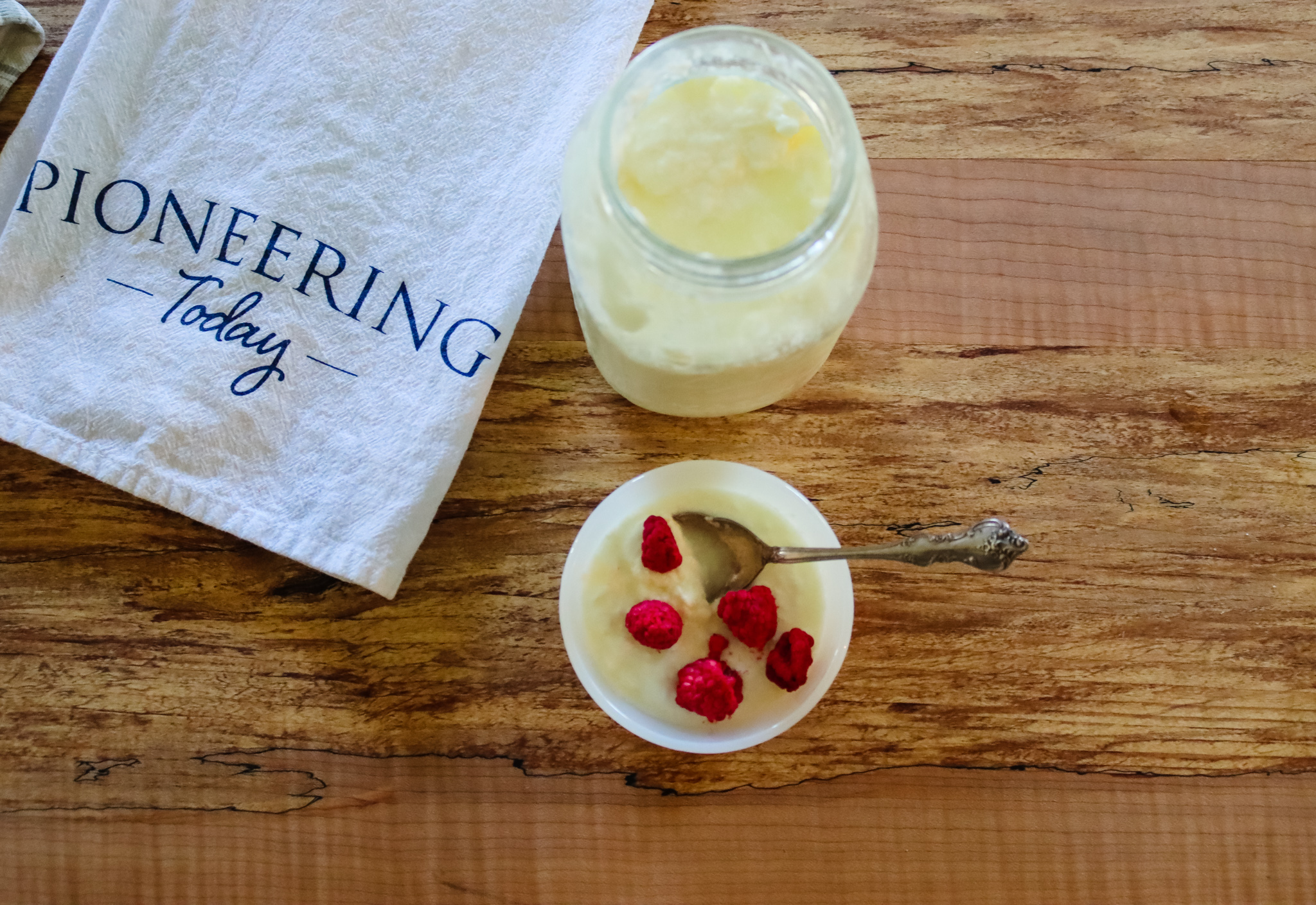
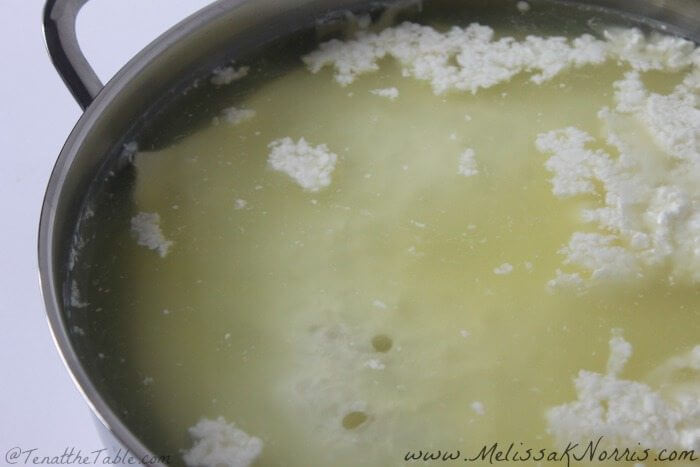
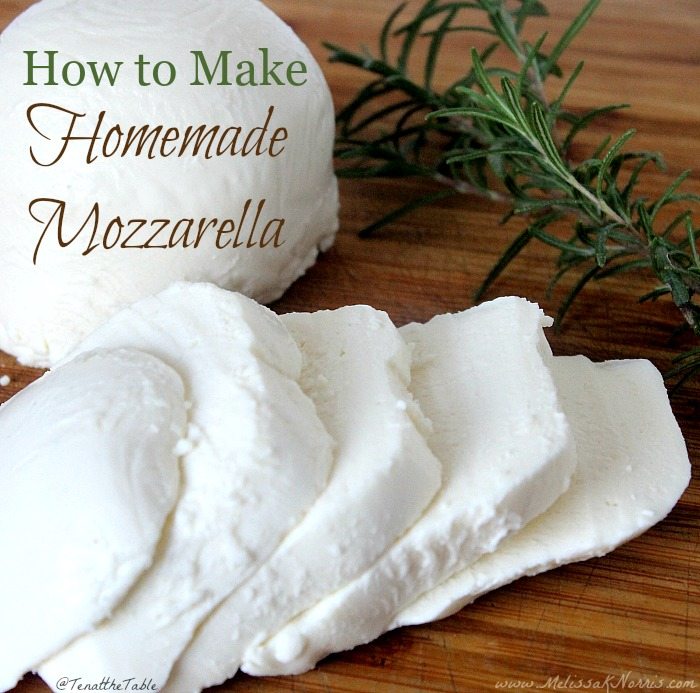
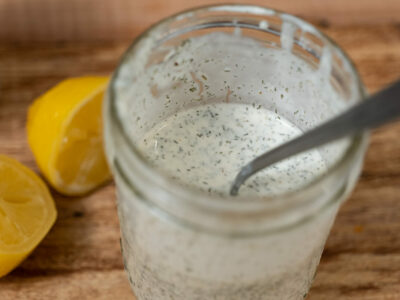


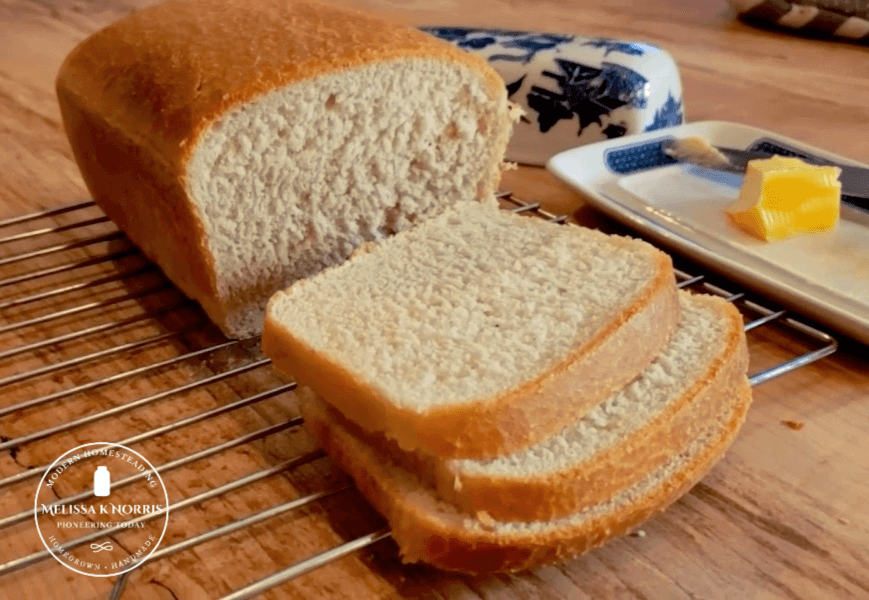
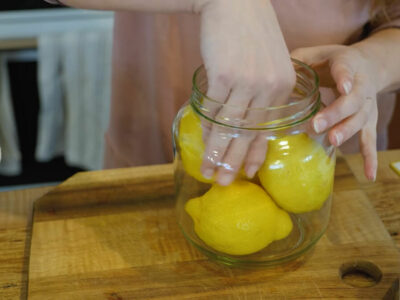



Thank you
For the culturing stage, to keep it at about 110 degrees, could I use a sous vide? It holds a pretty constant temp. My one concern is if I can seal the jar tight or do I need to keep the jar lid above water level and loose enough for gasses to escape?
Thanks so much for your amazing step by step! I got such great thick yogurt for the first time ! Absolutely can’t wait to continue to make it at home now as I really didn’t like the runny stuff but now it’s perfect?
what is your favourite way to flavour it ?
I’ve been using a reuteri culture and keeping it at 110 in my yogurt maker for 36 hours. Makes a tangy, thick yogurt that is yummy with my frozen blackberries.
Well, my crock pot was too hot on the lowest setting, and my oven & microwave were too hot. Instead, I used my dehydrator. Worked great!
I strain the whey off to make a thick yogurt. Would this whey be beneficial in the garden and if so, how and when would you apply it – full strength, diluted, poured on the top of he ground, or around the roots, sprayed onto the foliage, after seeds are up or when the plants are mature, or perhaps just in compost? Thanks for your advice. Love the video!
This is my first time making homemade yogurt. I used a plain greek yogurt as my starter. I had about a cup of whey, which I poured into a separate container. I mixed up what was left and it’s not very thick. Have I done something wrong? Am I supposed to leave in the whey? Thanks!
This was so easy! I wasn’t sure it would really work, since I’ve never done anything like it before. The organic milk I could get was homogenized and pasteurized and had to buy a 24 oz yogurt for starter. I used my microwave with over-stove light on and jar wrapped. It was quite warm when I took it out about 5 hours later. All worked and is delicious.
Hi Melissa! Thank you for all your share with us! I have only ultra-pasteurized organic milk available for making yogurt and it works very well! I don’t like the fact that it is ultra-pasteurized, but that’s all I have! It does work though!
Thanks!
The starter I get from the Amish store is a powder that only uses 1/8 t. per 4 cups of milk. It is sold by the teaspoon in tiny bags for about $4. I have always used whole milk, but never checked to see what kind of pasteurization method was used. I have a proof setting on my oven that I use for the fermentation process and it takes about 6 hours to set, but I have never had much luck using premade yogurt as the starter.
Fyi: Lots of local health food stores sell raw milk for “pet consumption only”… 😉 . That is where I purchase raw milk… for my pets, of course. ?
I use non-instant powdered milk, so no heating is required, just whisk or blend, put in instant pot. We like very thick yogurt, so I use 3 cups of powder (enough to make a gallon of milk) add starter and enough water to make a half-gallon and whisk. Put in four pint canning jars in my instant pot with water and rack. Run on yogurt setting for 12-14 hours. You can go down to 2 cups or less time if you like it thinner.
As started above the link for his to make raw milk yoghurt isn’t working. When I do a search of raw milk yoghurt on your site, it says no content matches.
I just got that fixed, here is the link
Can I use this recipe for raw goat milk? The link you have to a raw milk recipe isn’t working & goat milk is notorious for being a bit more runny.
I just got that fixed, here’s the link (I haven’t tried it with goat’s milk personally)
Can this work with dried powdered milk too? We have a bag of dry milk that we dont particularly like once made.
I’ve made yogurt for years and laugh to think of ways I’ve tried to keep the yogurt warm and cozy. Like wrapping in towels and standing on a heating pad set to low. (with a towel over it for insulation). Or using my canning pot filled with water and keeping it at 100 degrees. But that means hovering. Every so often taking its temp and heating it back up a bit. My kids finally got me a yogurt maker. This was when I was in CA. Now I’m in AL and you’d think regular pasteurized milk was illegal! I live in a remote area and can’t find good milk for my life. Even the Sprouts and Whole foods in Birmingham (100 miles away) don’t have decent milk! I’ve turned into a milk snob over the years. Now I’m seriously having to settle. Haven’t made any yogurt since moving. ah well. Still glad to be out of CA. Thank you for the recipe and getting me revved back up for yogurt.
This recipe sounds great. I have a couple of questions.
1) if I strain my yogurt, what do I do w/the liquid?
2) Can I use a good quality organic plain yogurt purchased from a local store as a starter?
3) How long will the starter last in the freezer?
3) Do I need to thaw the frozen starter before starting the next batch? If so, how? In the refrigerator, out @ room temp, etc?
4) I use a particular name brand of organic whole milk that is higher in protein & lower in sugar for both everyday drinking & baking. Can I use this in this recipe?
I really enjoy your emails & your ideas. Thank you!
The liquid from straining is whey, you can use it in smoothies, baking, or cooking.
As long as it’s a plain organic yogurt that says live cultures you can use it as a starter.
I’ve kept starter in the freezer for months, I don’t know if I’ve ever went longer than 6 months, but definitely past 3.
Yes, the frozen starter needs to thaw, I just put it on the counter an hour or two before heating the milk.
As long as the milk isn’t ultra-pastuerized it should be fine.
Hi there! Just ordered the starter, thanks for that suggestion! Are there any special things to know about how to prepare the starter when it arrives? Also, once the yogurt is made, how much of the yogurt do I add to the next batch to keep the cycle going? Many thanks! Love your podcast!
I am wanting to try this recipe, however, I am vegan. Can you use non-dairy milk in this recipe and yield similar results?
No, non-dairy milk won’t set up without an additional thickener and you’d need a non-dairy culture.
I’ve heard that soy milk makes great yogurt in an Instapot. I think my friend said that she uses a big spoonful of yogurt from the previous batch as her starter.
I just scored a yogurt maker and I too am vegan but allergic to soy. I’m still learning how to make non-dairy / non-soy yogurt. So far I learned that high fat and high protein milk is needed so coconut milk or any nut milk will work. I read that oat milk won’t work, but I have seen oat milk yogurt in the store. A little cornstarch or arrowroot can be added for thickener. I’m still looking for a good recipe.
I am very allergic to milk so I have started making my yogurt with quinoa milk. I use one cup of cooked quinoa to three cups of water and two dates. I then thicken two cups of the liquid with three tablespoons of potato starch or arrowroot. I had this very thick mixture back to the milk which is still in the blender. Blend it for a minute then I add my probiotic pills. I didn’t know there was a special culture for plant-based milks. I will look and try that. Anyway I had the culture, after I’m sure the temperature is correct then I put it in a sterilized quart jar and then in my dehydrator at 110 F for 8 to 12 hours and have yummy yogurt.
I’d love any ideas anybody else has on making plant-based milk yogurt.
I’m no dairy, gluten, corn and egg. Avoid soy as well. Very interested in what you ladies can inform me on your vegan versions of yogurt. Please keep me in the loop on how your plant based yogurt making adventures are going. Thank you.
I made yoghurt for the first time following your instruction. I used ultra-pasteurized milk because is so easy to find here in Costa Rica and last much longer than the good old keep in the fridge milk. My yoghurt turned out perfect. I strained it because I love thick yoghurt. It’s rich, creamy and so delicious. Thank you!
I just did my first batch :)!
From 4 cups of organic 3,8% milk and 1/2 cup of organic yogurt (with live culture).
It worked :D! I’m amazed <3
Congrats, isn’t it an amazing feeling when you discover you can make it at home so much cheaper than the store and it’s easy! 🙂
So many informations 😀 I started going back to old podcasts resources to make sure I get them all pinned on my Pinterest boards, so I can find them when I need them, but I keep finding more and more interesting stuff ;)! I have 5 “Pioneering Today” tabs opened on my computer right now, haha! This is great.
I hope I can find the right type of milk to try this! Thanks so much! You’re the best!
I love hearing this Julie!!
I’ve been making yogurt for about 2 years, and I STILL feel like it’s a mini-miracle every single time. I do a gallon at a time, and incubate in the oven with just the light on, in the same pot used for heating the milk. Less dishes, no spill on the counter. It lasts for several weeks. I do strain it; that way you can use it as a sour cream replacement too. Strain it further and you have a sub for cream cheese.
Perfect timing for this blog post because I just made homemade yogurt this week! I have always used my slow cooker and it works well for me. The only part I hate is that I like the Greek yogurt consistency so it takes me a couple of days to strain my whole batch (using coffee filters). I am sure I could cut that time down if I just spent the few dollars to buy a larger strainer and some industrial sized coffee filters instead of the little ones I use. Not sure why I haven’t done that yet!!! Then I save 1/2 cup of my strained yogurt to start my next batch. Like some of your other readers, I can’t find any raw milk or any milk that is not homogenized or pasteurized. I do buy organic though and I may look into trying the cultures you use. Thanks for an awesome blog, Melissa!
Stephanie,
So glad you enjoy the blog and I’ve had fun playing with different cultures, hope you do too!
Asian Indians use a similar method but no culture required. We boil milk, let it cool (I know it may sound weird but we just stick our finger into the milk to see if it’s lukewarm) then add 1/2 cup of store bought plain yogurt or leftover yogurt from the last time it was made. Whisk it up and store in the microwave or oven (which we usually do overnight) for 6-8 hrs and then refrigerate.
I’m not sure how much the culture costs but once you get one batch of yogurt made – you won’t have to pay a penny for anything besides the milk. Hope this helps!
Lovely! I also use your method, but then I keep it for the whole night in a food thermos. Easy peasy!
Great tip, Ana!
[…] your normal routine, then move on. It might be homemade bread (or this no-knead 5 minute bread), homemade yogurt, or a condensed can of soup […]
Seeing this recipe/video has inspired me! I want to try making my own yogurt, do you know if it’s possible to add honey for some additional flavor? Maybe after it’s done fermenting? Also would this method work if I used the Greek yogurt starter from the same company? Thank you for inspiring me!
Just make sure you take out your amount for the next batch before adding honey. I usually just add the honey to the amount we’ve dished out at the time of eating. Yes, same method would work with the Greek yogurt starter
where do you purchase your starter. I’ve never seen anything in my stores around here.
Michelle,
I purchased mine from Cultures for Health.com
Thanks, Melissa. There were quite a few technicalities I didn’t know about. I generally am successful with my yogurt but it doesn’t always keep that well.
Btw, I incubate mine in a vacuum flask (do you call them that in the US? A Thermos?) cos it keeps it at a steady temperature with no fuss. I just have to remember to stick a big “YOGURT” sticker on it so that no one assumes it has hot water in it, left over from the last kettle-boiling! (Nasty surprise!)
Angela,
I’d have never thought of a Thermos, but that would work fabulous. I’ll have to try it!
Am new to your site, and love it
Had no idea yogurt making was so easy
Will take a few attempts to get a real feel for it,
but am excited about what I’ve done so far
Many tnx for sharing/ca
What a blessing for you that you are able to purchase non-homogenized and non-ultrapasteurized milk. I can’t find that here in Louisiana. And raw milk – forget it. It’s against the law to sell it. It was quite disappointing to discover this after I moved here.
I understand your frustration. I am from Louisiana and I am frustrated also. would love to have some raw milk.
Fyi: Lots of local health food stores sell raw milk for “pet consumption only”… 😉 . That is where I purchase raw milk… for my pets, of course. ?
Love it ?????
Thanks, Melissa for this helpful information. Question–does the yogurt become thinner with successive batches when you use yogurt from a previous batch for the starter? Thanks!
Mine actually became thicker and now stays consistently the same and I’ve never used a “new” starter, just always saved it from the previous batch.
However, if it did all of a sudden start to stop fermenting and thickening, it’s probably because you’re starter is “dying”. But unless that happens, I’d keep using the saved yogurt from the previous batch.